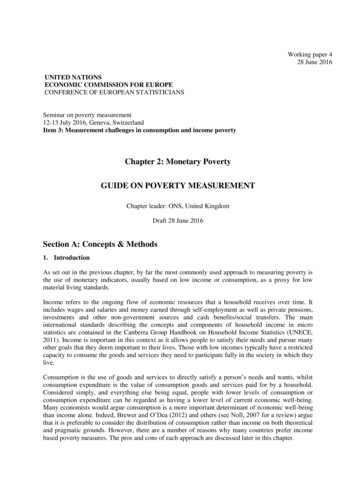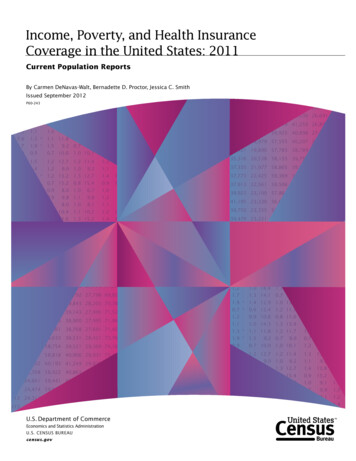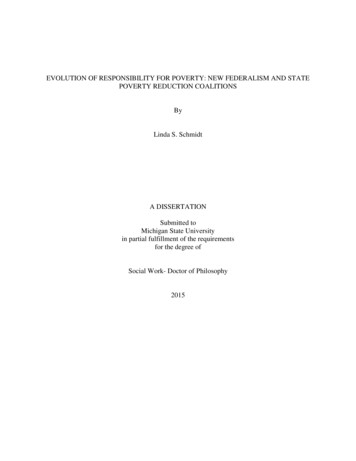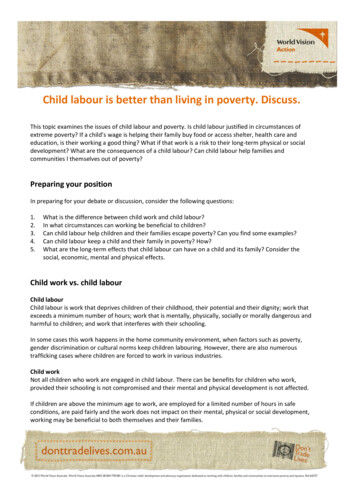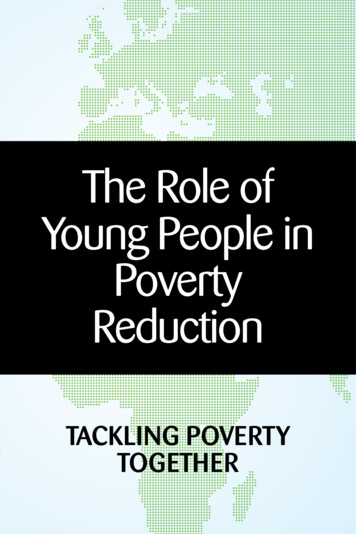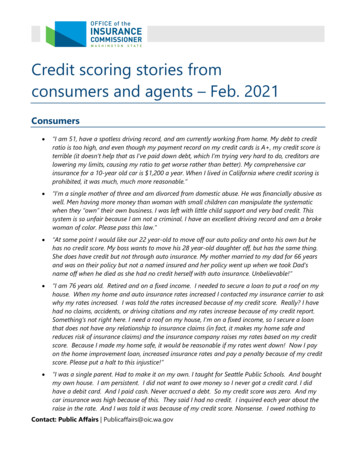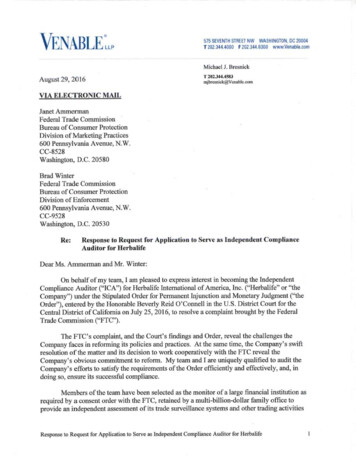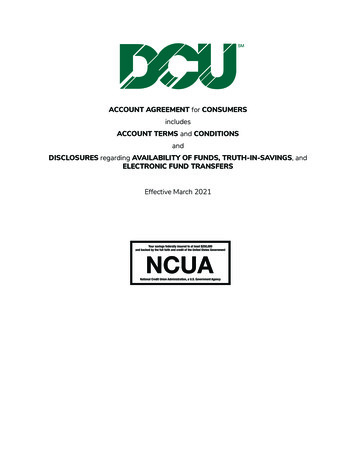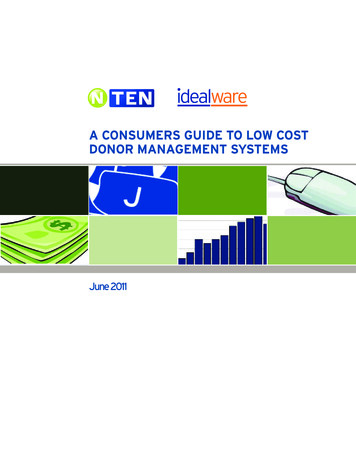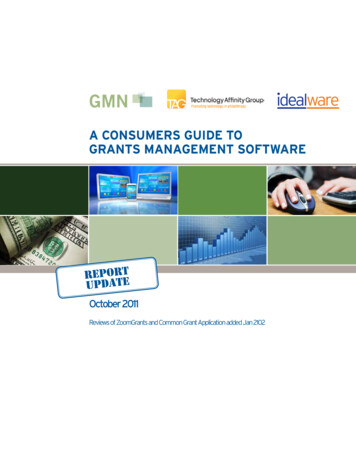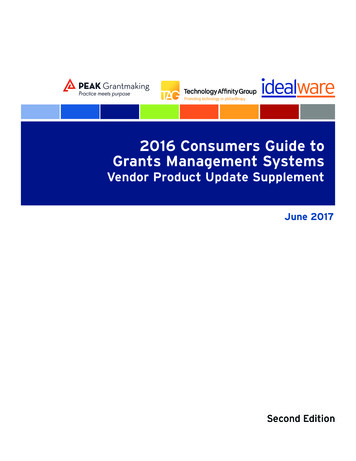
Transcription
Policy ReportMay 2015Energy poverty and vulnerable consumersin the energy sector across the EU: analysisof policies and measuresLead Authors:Steve Pye (UCL), Audrey Dobbins (USTUTT)Authoring Team:Claire Baffert (KIC InnoEnergy)Jurica Brajković, Ivana Grgurev (EIHP)Rocco De Miglio (E4SMA)Paul Deane (UCC)Reviewers:Bruno Lapillonne (Enerdata)Carine Sebi (Enerdata)Legal notice: Responsibility for the information and views set out in this report lies entirely with the authors.This report is also available on our website: www.insightenergy.org2
Energy poverty and vulnerable consumersin the energy sector across the EU: analysis of policies andmeasuresPolicy Report2ii
Energy poverty and vulnerable consumersin the energy sector across the EU: analysis of policies andmeasuresPolicy Report2ABOUT INSIGHT EINSIGHT E is a multidisciplinary energy think tank which provides the European Commission andother energy stakeholders with advice on policy options and assesses their potential impact.The INSIGHT E consortium is formed by twelve complementary partners representing varioussectors: academia, research centres, consultancies, one think tank, one stakeholder organizationand one of the Knowledge and Innovation Community of the European Institute of Technology. Ourpartners are based in ten European countries. This sectoral and geographical diversity is alsoreflected in the thematic scope of INSIGHT E, ranging from energy infrastructure, new energytechnologies to economic analysis, geopolitics and trade, environmental and climate impact, andsocial and behavioral change.To receive regular updates about INSIGHT E programme of work and to learn more aboutparticipation opportunities, please visit the following links:Website: www.insightenergy.orgContact us: info@insightenergy.orgFollow us on: Facebook & LinkedIn: Insight Energy and on Twitter: INSIGHT E@EuropeEnergyEnerdataInstitut Français desRelationsinternationalesEnergy Institute"Hrvoje Pozar"Paul Scherrer InstituteEnergy EngineeringEconomic EnvironmentSystems Modeling AndAnalysis SRLStakeholder Forum fora Sustainable FutureKIC InnoEnergyUniversity of StuttgartKarlsruhe Institute forTechnologyUniversity College CorkKTH Royal Institute ofTechnologyUniversity CollegeLondoniii
Energy poverty and vulnerable consumersin the energy sector across the EU: analysis of policies andmeasuresPolicy Report2TABLE OF CONTENTSExecutive Summary . vList of Figures .ixList of Tables . xCase Studies .xiAcronyms . xiiCountry Abbreviations used . xiiiAcknowledgements . xivI. Introduction . 1II. EU efforts in addressing energy poverty . 3II.A. European legislation . 4II.B. Current status of action . 6III. Vulnerable consumers and energy poverty in the EU . 9III.A. Indicators for EU energy poverty analysis . 9III.B. EU research initiatives on energy poverty . 17IV. Member State review . 26IV.A. Member State approaches to addressing the issues . 26IV.B. Measures to protect vulnerable consumers and tackle energy poverty . 44IV.C. Key findings from Member State review . 57V. Recommendations . 62VI. References . 72Appendices . 77Appendix I. Vulnerable Consumers and Energy Poverty in Member States: Country summaries . 77Appendix II. Vulnerable Consumers and Energy Poverty in Member States: Country reports . 77Appendix III. European Stakeholders for Energy Poverty . 77Appendix IV. European Energy Poverty Research Initiatives . 77iv
Energy poverty and vulnerable consumersin the energy sector across the EU: analysis of policies andmeasuresPolicy Report2EXECUTIVE SUMMARYEnergy poverty, often defined as a situationwhere individuals or households are not ableto adequately heat or provide other requiredenergy services in their homes at affordablecost, is a problem across many MemberStates. This is due to rising energy prices,recessionary impacts on national and regionaleconomies, and poor energy efficient homes.The EU Survey on Income and LivingConditions (EU SILC) estimates that 54 millionEuropeancitizens(10.8%oftheEUpopulation) were unable to keep their homeadequately warm in 2012, with similarnumbers being reported with regard to thelate payment of utility bills or presence of poorhousing conditions. Based on these proxyindicators, a particularly pervasive problem ishighlighted in Central Eastern European andSouthern Europe Member States.It is important that Member States recogniseand address this problem, as ensuring basicenergy services is critical to ensure thatcommunities do not suffer negative healthimpacts, do not become further entrenched inpoverty, can maintain a good quality of life, aswell as ensuring the financial outlay to assisthouseholds that require support does notbecome too burdensome. While allowing forfullcompetitioninenergymarkets,Governments and regulators have a role toprotect the most vulnerable communities, andprevent groups in society falling into energypoverty. The functioning of energy marketscan clearly have an impact on this situation,through ensuring consumer protection andsafeguards, offering competitive tariffs (andaccess to them) and assisting in the efficientuse of energy.This policy report from the INSIGHT Econsortium assesses how Member Statesdefine the issue of energy poverty andvulnerable consumers, and the measures thathave been implemented to address theseissues. Under the Third Energy Package,Member States need to identify vulnerableconsumers and put measures in place thataffords them adequate attention, and whereappropriate, address issues of energy poverty.Key findings: definitions Definitions used for vulnerable consumers varysignificantly across Member States, reflectingdifferences in problem identification and inapproaches to action. Less than a third of Member States explicitlyrecognise concepts of energy poverty. Thosethat do see it as a linked yet distinctiveproblem from vulnerable consumer protection.Our review highlights the quite distinctiveways in which Member States have bothrecognised and chosen to address the issuesof vulnerable consumers and energy poverty.While this strong subsidiarity approachrecognises national differences, it means thereis a danger of Member States not addressingthe dual challenges of additional consumerprotection and access to the markets forvulnerableconsumers,andenergyaffordability concerns. There is also a risk ofvulnerable consumer actions not being alignedwith or contributing to measures to addressenergy poverty.The report also highlights that energy povertyis a linked yet distinctive issue from vulnerableconsumers, and requires different metrics todefine it and measures to tackle it. Weestimate that less than a third of MemberStates recognise energy poverty at an officiallevel, while only four countries have legislateddefinitions (UK, Ireland, France, Cyprus).However, it should be noted that manyv
Energy poverty and vulnerable consumersin the energy sector across the EU: analysis of policies andmeasuresPolicy Reportcountries do have civic organisations engagedin trying to tackle the problem in localcommunities around Europe. The study alsohighlights that energy poverty is not only aregulated energy markets issue; in fact, itmaybemoreprevalentinoff-gridcommunities, or those associated with othernational markets e.g. district heating. Inaddition, it should not only be regarded as anaffordable heating issue but cooling too, andcould also include energy expenditure formobility.The distinctiveness of the issues points toseparatingoutactionunderdifferentstrategies, and to that end we make a numberofrecommendations.Wheredifferentstrategies exist, it is important that they areconsistent and mutually reinforcing. It is alsoapparent that this is quite a new area of policymaking that is challenging, particularly itionsandeffectivetargetingofmeasures. Therefore, we consider the sharingof best practice between Member States ondefinitions, data and measures to be critical,and one that can be facilitated by theCommission.Key findings: measures Financial interventions are a crucialmeans of short-term protection forvulnerable consumers. Many MemberStates use the social welfare system toboth identify recipients of support anddistribute payments. Enhanced targetingof energy-poor needs to be balancedagainst administrative complexity. Additionalconsumerprotectionmeasures focus on vulnerable consumerprotection,andaredominatedbydisconnection protection. This categoryalso has a diverse set of measures,primarily coordinated by regulators andenergy supply companies. Many measurese.g. billing information, codes of conduct,debt protection are often most prevalent instrongly liberalised markets.2 Energyefficiencymeasures,particularly those focusing on buildingretrofit, are a key part of a strategy toaddressenergypoverty.Thereisconsiderable scope for increased targetingof such measures, although this requiresan understanding of which are the energypoor households. There are a wide rangeof approaches to implementation e.g.funding source, extent of targeting,implementing body. Such factors need tobe considered in view of nationalcircumstances. There are already wellunderstood barriers to energy efficiencymeasures. Strong incentives for take-up inlow income households are needed, anddesigned to promote awareness and keybenefits. Informationprovision,includingmeasures relating to price comparison andtransparent billing, are often found inMember States with the most liberalisedmarkets. Where there is a strong civicsociety movement in relation to energy orfuel poverty, the number of awarenesscampaigns is higher. Greater awarenessof energy poverty and how to tackle itcould come through the greater use ofsmart metering.While definitions are critical for orientatingaction towards the challenges of vulnerableconsumers and energy poverty, effectiveaction then needs to be developed, in the formof strategies and policy measures. It is evidentthat a range of policy measures is required toaddress these different challenges, tailoredtowards national circumstances (the policyapproach, extent of market liberalisation, andphysical characteristics of household energyand building ng affordability in the short term, andcan be used to complement longer termmeasuresthataddresstheunderlyingstructural issues of energy poverty. Forexample, in Scandinavian countries and theNetherlands, social support is provided butalso significant effort has been and is beingvi
Energy poverty and vulnerable consumersin the energy sector across the EU: analysis of policies andmeasuresPolicy Reportput into improved energy efficiency of socialhousing stock. This integrated approachmeans that financial support does not becomethe main policy for ensuring affordability but israther a transition measure, which remains toensure a safety net but is not relied upon.Member States have used many differentfinancial mechanisms, either through socialwelfare payments, or direct payments tospecific groups e.g. elderly, to assist withenergy bills. A number of Member States alsohave social tariffs in place, ensuring that morevulnerable consumers can access the mostaffordable energy.Targeted consumer protection measures areparticularly important for vulnerable consumerprotection (and access) in regulated markets.Therefore, there are particularly strong rolesfor National Regulatory Authorities (NRAs) andenergy companies. They are critical forensuring that markets operate in a way thatdoes not disadvantage vulnerable consumers,through guaranteeing supply, establishingcodes of conduct for market players, and bycompanies identifying vulnerable consumers.There is considerable potential for much moretargeting of energy efficiency measures acrossMember States, to better address energypoverty, and increase energy affordability forthose most vulnerable to higher prices.However, targe
Energy poverty and vulnerable consumers in the energy sector across the EU: analysis of policies and measures Policy Report 2 v E XECUTIVE S UMMARY Energy poverty, often defined as a situation where individuals or households are not able to adequately heat or provide other required energy services in their homes at affordable
